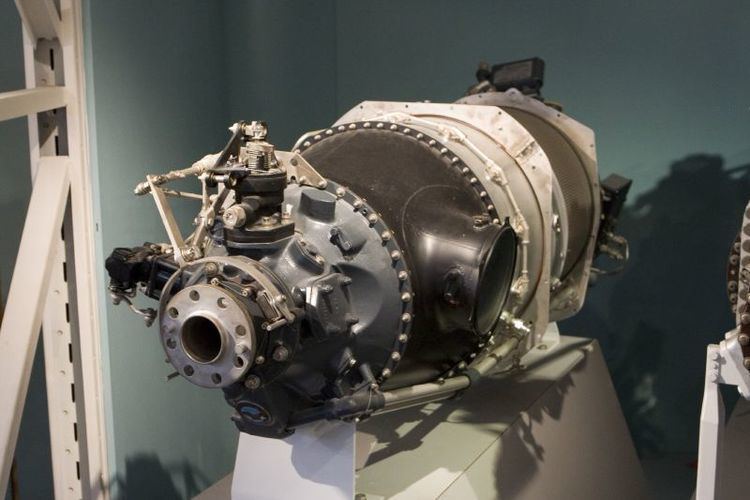 | ||
The Pratt & Whitney Canada PT6, produced by Pratt & Whitney Canada, is one of the most popular turboprop aircraft engines in history. The PT6 family is known for its reliability with an in-flight shutdown rate of 1 per 333000 hours since 1963, 1 per 651,126 hours over 12 months in 2016. Time between overhauls are between 3600 and 9000 hours and hot section inspections between 1800 and 2000 hrs.
Contents
- Design and development
- PT6A
- PT6B
- PT6C
- PT6D
- PT6T
- ST6
- STN
- Engines on display
- Specifications PT6A 6
- General characteristics
- Components
- Performance
- References
In US military use, they are designated as T74 or T101. The main variant, the PT6A, is available in a wide variety of models, covering the power range between 580 and 920 shaft horsepower in the original series, and up to 1,940 shp (1,450 kW) in the "large" lines. The PT6B and PT6C are turboshaft variants for helicopters.
Design and development
In 1956, PWC's President, Ronald Riley, foreseeing the need for engines with much higher power-to-weight ratio, ordered engineering manager Dick Guthrie to establish a development group to create a turboprop engine designed to replace piston engines. Demand for the Wasp radial engine was still strong and its production line's output was robust and profitable. Riley gave Guthrie a modest budget of C$100,000. Guthrie recruited young engineers from the National Research Council in Ottawa and from Orenda Engines in Ontario. In 1958, the group began development of a turboprop engine intended to deliver 450 shaft horsepower. The first engine was powered up and run successfully in February 1960. It first flew on 30 May 1961, mounted on a Beech 18 aircraft at de Havilland Canada's Downsview, Ontario facility. Full-scale production started in 1963, entering service the next year. By the 40th anniversary of its maiden flight in 2001, over 36,000 PT6As had been delivered, not including the other versions. The engine is used in over 100 different applications.
All versions of the engine consist of two sections that can be easily separated for maintenance: a gas generator supplies hot gas to a free power turbine. The starter has to accelerate only the gas generator, making the engine easy to start, particularly in cold weather. Air enters the gas-generator through an inlet screen into the low-pressure axial compressor. This has three stages on small and medium versions of the engine and four stages on large versions. The air then flows into a single-stage centrifugal compressor, through a folded annular combustion chamber, and finally through a single-stage turbine that powers the compressors at about 45,000 rpm. Hot gas from the gas generator flows into the power turbine, which turns at about 30,000 rpm. It has one stage on the small engines and two stages on the medium and large ones. For turboprop use, this powers a two-stage planetary output reduction gearbox, which turns the propeller at a speed of 1,900 to 2,200 rpm. The exhaust gas then escapes through two side-mounted ducts in the power turbine housing. The turbines are mounted inside the combustion chamber, reducing overall length.
In most aircraft installations the PT6 is mounted backwards in the nacelle, so that the intake side of the engine is facing the rear of the aircraft. This places the power section at the front of the nacelle, where it can drive the propeller directly without the need for a long shaft. Intake air is usually fed to the engine via an underside mounted duct, and the two exhaust outlets are directed rearward. This arrangement aids maintenance by allowing the entire power section to be removed along with the propeller, exposing the gas-generator section. To facilitate rough-field operations, foreign objects are diverted from the compressor intake by inertial separators in the inlet.
Several other versions of the PT6 have appeared over time. The Large PT6 added an additional power turbine stage and a deeper output reduction, producing almost twice the power output, between 1,090 and 1,920 shp (1,430 kW). The PT6B is a helicopter turboshaft model, featuring an offset reduction gearbox with a freewheeling clutch and power turbine governor, producing 1,000 hp (750 kW) at 4,500 rpm. The PT6C is a helicopter model, with a single side-mounted exhaust, producing 2,000 hp (1,500 kW) at 30,000 rpm, which is stepped down in a user-supplied gearbox. The PT6T Twin-Pac consists of two PT6 engines driving a common output reduction gearbox, producing almost 2,000 hp (1,500 kW) at 6,000 rpm. The ST6 is a version intended for stationary applications, originally developed for the UAC TurboTrain, and now widely used as auxiliary power units on large aircraft, as well as many other roles.
When de Havilland Canada asked for a much larger engine, roughly twice the power of the Large PT6, Pratt & Whitney Canada responded with a new design initially known as the PT7. During development this was renamed to become the Pratt & Whitney Canada PW100. Turboprops such as the PT6 and PW100 may have a bypass ratio over 50, although propeller airflow is slower than for turbofans.
In-flight shutdown rate was 1 per 127,560 hours in 2005 in Canada, 1 per 333,333 hours up to October 2003, with 31,606 delivered engines flown more than 252 million hours. The PT6 family logged 400 million flight hours from 1963 to 2016 while power-to-weight ratio was improved by 50%, brake specific fuel consumption by 20% and overall pressure ratio reached 14:1.
Its development continues and while today its high-level configuration is the same as in 1964, P&WC updated the PT6 including single-crystal turbine blades in the early 1990s, and FADEC should be introduced. Its pressure ratio is 13:1 in the AgustaWestland AW609 tiltrotor.
PT6A
The PT6A family is a series of free turbine turboprop engine providing 500 to 1,940 shp (433 to 1,447 kW)
PT6B
PT6C
PT6D
PT6T
ST6
STN
PT6B
PT6C
PT6D
ST6
STN
Engines on display
Specifications (PT6A-6)
Data from Jane's 62-63, helicopter annual 2009
